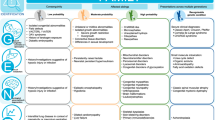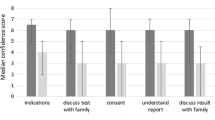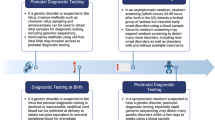Abstract
Emergencies occur unpredictably and interrupt routine genetic care. The events after hurricanes Katrina and Rita have led to the recognition that a coherent plan is necessary to ensure continuity of operations for genetic centers and laboratories, including newborn screening. No geographic region is protected from the effects of a variety of potential emergencies. Regional and national efforts have begun to address the need for such preparedness, but a plan for ensuring continuity of operations by creating an emergency preparedness plan must be developed for each genetic center and laboratory, with attention to the interests of patients. This article describes the first steps in development of an emergency preparedness plan for individual centers.
Similar content being viewed by others
Main
Emergencies have interrupted genetic services in various American regions affecting diverse healthcare capacities within the genetic care network. The most dramatic example may be the 2-year interruption of in-state newborn screening (NBS) and 6-month shutdown of clinical biochemical genetics laboratory services in Louisiana after the effects of hurricanes Katrina and Rita.1,2 Other less widespread emergencies such as electrical outages at the Wadsworth Center (Ken Pass, personal communication) and an ice storm at Greenwood Genetics Center (Tim Wood, personal communication) have interrupted laboratory services. Any of these events threaten continuity of operations (COOP), which is relied upon for management of patients at risk for becoming rapidly and catastrophically ill.
National efforts by the Centers for Disease Control and Prevention, Health Resources and Services Administration, and the American College of Medical Genetics have begun to address the need for emergency preparedness (EP) programs.3 But EP for clinical genetics centers and laboratories must address the imperative to maintain the genetic care network, which includes (1) each NBS and follow-up program; (2) genetic centers and their healthcare teams and laboratories; (3) and the patients who are affected by genetic diseases, especially those with inborn errors of metabolism. This article offers a primer on development of EP from the perspective of the medical genetic network.
The affected population and the extent of any emergency define the measures that may be necessary to support COOP with limited morbidity and mortality. Although the population interests and needs can be defined in advance, the extent of a disaster is, by definition, entirely unpredictable. This article focuses on steps that can be taken to ensure continuity of care services during and immediately after an emergency from the perspective of three groups: (1) the medical service provider and the metabolic nutritionist (collectively, the clinical providers); (2) the diagnostic service provider (laboratorian); and (3) the patient and/or their caregiver and guardian (consumer). The coordinated actions of these three groups will determine the continuity of services for the affected population, some of whom may be undiagnosed newborns whose timely NBS results reporting is crucial to favorable outcomes.
Disaster response plans typically describe four phases: preparedness, response, recovery, and mitigation.4 Preparedness describes the actions taken before an emergency, whereas response is the action taken after an emergency occurs. Recovery is the steps taken after initial responses to return conditions to their preemergency state. Mitigation may occur within any of the other phases and refers to any action that may lessen the impact of the emergency. Several assumptions apply to the circumstances and environments of the larger genetic network within an emergency:
-
1
NBS programs and medical genetic centers often exist within larger organizations, such as state health departments or medical schools. These large environments may offer established EP programs, and the genetic network should proactively participate in the EP programs within host environments. Public sector organizations often have more mature EP programs than private sector organizations. Furthermore, all entities within disaster-prone regions are more likely to have developed EP programs, but these programs have not been emphasized within the genetic network.
-
2
All responses to emergencies begin locally and outside resources, if engaged at all, take many days to become effective. This assumption highlights the critical need for self-preparation of genetic programs for response and recovery steps; preparedness should also be developed by and for consumers. Each entity must be capable of continuing care/operations independently or transferring the responsibility, hopefully seamlessly, for genetic activities to another capable entity.
-
3
A key principle in any preparedness plan is redundancy of every element and function within the unit. Each person's role and all resources should be backed up by a second person or resource in the event of a failure or absence of the first-line resource.
-
4
Spiral evolution of the EP plan should occur. EP is a continuous activity that requires intermittent testing of the plan through exercises and remediation of deficiencies. An EP plan must regularly and continuously be consulted and revised through exercises if preparedness is to be successful. A plan cannot be developed and placed on file for use in the event of an emergency. Preparedness describes the functioning of a coordinated unit, and the plan must be exercised with some regularity (at least every 6–12 months) for the members of the unit to know their response once the plan is activated (Table 1).
Table 1 Emergency preparedness activity matrix
ELEMENTS OF AN EP PLAN
Command and control hierarchy
A hierarchy of individuals with clear roles and responsibilities is critical for coordinated responses to an emergency. The hierarchy of the genetic center (or laboratory) may be one component of a larger hierarchy within the larger organization of a medical school or healthcare system. The genetic center hierarchy must have an assigned leader and coleader (see the redundancy principle) who have considered what conditions should exist for an activation of the EP plan. A clear hierarchy (a sample hierarchy is shown in Fig. 1) with roles and responsibilities should be established for each member with plans for backup in the event of the absence of any member. The units identified within the hierarchy should develop a plan for vertical communication within the unit and horizontal communications between units. The hierarchy should be revised regularly to account for changes in personnel and their responsibilities. An EP coordinator should be identified within the hierarchy to be responsible to organize the EP plan and facilitate exercises.
Resources that relate to the hierarchy should include a complete directory of all members of the unit including primary and secondary contact telephone numbers, e-mail, and physical addresses, including the address to which each member will likely travel in the event of an evacuation; this list should be updated regularly and maintained by the EP coordinator. The directory should be available to all hierarchy members online (with privacy protection), in print within the institution, and in backed-up media held by each unit. Similar contact information should also be obtained from all patients during routine clinic visits. Clinic visits are a useful time to ask patients if they have a plan for an emergency, to discuss other genetic care centers in the event of evacuation, and to share Web site addresses, e-mails, and online groups, which can be created specifically for establishing contact in the event of evacuation after the loss of routine mechanisms for contact (e.g., office and home telephones).
Alternative communications planning
In an emergency that impairs power, one of the first resources to be lost is the ability to communicate normally. Cellular systems, landlines, the World Wide Web, and access to the Internet are often incapacitated. Preparation for alternative mechanisms of communication and virtual (online) meeting sites can be very useful in reorganizing a hierarchy whose members have physically scattered to disparate locations. Online user-groups (e.g., Google Groups and Yahoo Groups) can be established during preparation (before an event) to serve as a virtual meeting site for hierarchy members and patients once access to internet is reached after an evacuation or once power has been reestablished. These mechanisms can also be used to reestablish contact with evacuated patients if they are instructed ahead of the emergency to log into the Web site and given access.
In response and recovery phases, internet-based conferencing systems and voice-over-internet-protocols offer mechanisms for communication and reorganization of the hierarchy. In the severest emergency, in which the Internet is unavailable to members within an affected area, laptops with conferencing software connecting through satellite modems (which can be powered by batteries or automobile power) allow real-time communications even during the emergency. During the post-Katrina flooding, the municipal New Orleans government used such a laptop connection as the only means of communication for a period in the early days of the disaster when power, landlines, and internet failed.5
COOP and transfer of services for laboratories
During a disaster, laboratory services may be impaired or discontinued for an indeterminate period of time. After the destruction of the Louisiana state NBS laboratories in post-Katrina flooding, the state genetics program rapidly arranged, through the Emergency Management Assistance Compact6 to request Iowa State Hygienic Laboratory perform NBS for Louisiana newborns.1,2 Within 10 days, and for 2 years after the disaster, Iowa performed screening and reported the results back to the Louisiana genetics program that managed cases routinely, albeit at clinics outside of New Orleans. The only biochemical genetics laboratory in Louisiana was also unavailable for approximately 6 months. Therefore, additional diagnostic and monitoring samples were performed by three biochemical genetics laboratories: (1) University of Maryland Medical Center; (2) Children's National Medical Center; and (3) Miller Medical School. Although no known adverse events occurred in the wake of Katrina's flooding, this was only possible by a network of helpful colleagues.1
EP of NBS laboratories and genetic diagnostic laboratories must include plans for COOP. The most urgent issues are mechanisms for identifying samples that may be in various stages of preparation or analysis that have not yet been reported. Samples that are in transport and have not yet been received by the laboratory must be accounted for by the sending entity. Prompt identification of these samples and reporting the inability to complete the analysis in a timely manner are critical to getting such patients back into clinics for reassessment and submission of repeat samples. Samples that cannot be reported out may be identified online if a virtual record is maintained when accessioning samples. Several states have developed plans for rapid transfer of NBS if one should become unable to perform normally. The Florida and Texas Newborn Screening Programs have developed such a plan (Lois Taylor, personal communication) and states within the Heartland Regional Genetics Collaborative have run exercises to demonstrate their ability to rapidly assume NBS for each other.7 Important considerations that add complexity to such plans are variable state-specific assignments of disorders tested for and abnormal thresholds, variable demographics collected for each state, and diversity in reporting results.8 Health Resources and Services Administration and the Centers for Disease Control and Prevention have held a 2-day workshop (September 25–26, 2008) to develop a contingency response plan for NBS laboratories in an emergency.9
Access to e-medical records
Patients in an emergency who evacuate their medical home require a plan for accessing specialized medical care in other communities. An EP plan for consumers must consider options for care for a patient in the event of the loss of their medical home. Discussion and consideration of options for care should occur in clinic visits with guidance by the geneticist and consideration of likely communities to which the patient will evacuate. Such a plan is facilitated by a geographic directory of specialized genetic care resources such as that found on the Southeast Region Genetics Collaborative (SERC) Web site (http://www.southeastgenetics.org/directory). Creation of each patient's virtual (e-medical) record that can be communicated to a new medical home can facilitate assumption of seamless medical care for a patient who may be required to evacuate to a new city. Some e-medical record systems within a hospital/clinic may not be recoverable remotely in the event of a disaster. Consideration should be given to a “skeleton-record” that includes recent medications and laboratory results and also confirms the correct diagnosis and therapy to the new medical home. Some groups have developed wallet-sized cards to use in emergencies in addition to health records on web portals and thumb drives because computer access may be limited. Consumers are not the most accurate source for medical history, and an incorrect therapy based on misinformation can be disastrous. Some clinics may allow patients to develop an e-medical record themselves with records given by the genetic clinic, but patients may not have access to or facility with computers.
A recent EP exercise at the 2010 annual meeting of the SERC demonstrated the use of virtual medical records in the “care” of mock patients who had evacuated their medical home and presented themselves to a new medical home. Using the Midwest Emergency Medical System for Children Information System (now renamed MyEIF), an online emergency medical record system, healthcare participants were presented with new metabolic disease “patients” to their mock clinic and were required to log into Midwest Emergency Medical System for Children Information System to evaluate the medical record and create a care plan. Other regions (New York Mid-Atlantic Collaborative) have proposed a thumb drive-based record that the patient carries with them and may be updated at clinic visits. Consumers may also create their own e-medical record using one of many Internet-based systems for personal health records. One or more of these mechanisms should be considered as part of the EP plan of any genetic medical home.
DEVELOPING AN EP PLAN
In developing a new EP plan, four elements of a plan should be considered for which there could be emergency management phase-related activities. Procedures describe the actions that drive the plan, including the development of a hierarchy and assigning the roles of each member, linking to other hierarchies or plans, exercises that may be conducted to test preparedness and plans with patients and other laboratories to address COOP. Facilities describe the structures and equipment that are used in the operations of the center, laboratory, or consumer. Supplies are required by all members of the hierarchy and must be accounted for in an EP plan. Personnel are the human resources that must protected and, when possible, organized within the plan. A mature plan will consider the role of each element in preparedness, response and recovery, develop, and conduct intermittent exercises to evaluate readiness of all elements in each phase and take steps to update and improve the plan. This approach can be adapted for clinical centers, laboratories, and consumers; the latter group can become part of exercises that the center may run. Proposed steps within each phase of the plan can be downloaded and considered in the SERC strategic plan (http://www.southeastgenetics.org).
Anticipatory guidance for patients may be provided routinely at semiannual or annual clinic visits. Letters and e-mails sent to all patients with “steps-to-take” and resources for communication (e.g., Web sites and cellular telephones) may be sent out annually to remind patients of their own preparedness steps and give them an enduring list of resources that they can carry with them. Consumers should be encouraged to form networks of patients who can also act to support each other in circumstances of an emergency.
EP constitutes a series of steps that can be taken by any genetic organization, laboratory, or patient to ensure COOP and access to care for patients. As patients, especially those with inborn errors of metabolism, can become catastrophically ill in the absence of expert care, specialized medical foods and pharmaceuticals, and requiring access to urgent specialty laboratory tests, preparedness is an essential component of their healthcare plan. A partnership between the clinical team and the patients with shared responsibilities can allow effective COOP. Preparedness is a continuous process that must be revisited intermittently and tested for adequacy with exercises, the remediation of which can lead the spiral evolution to a mature plan.
REFERENCES
Andersson HC, Narumanchi TC, Cunningham A, Bowdish B, Thoene J . Genetic/metabolic health care delivery during and after hurricanes Katrina and Rita. Mol Genet Metab 2006; 88: 3–6.
Lobato MN, Yanni E, Hagar A, et al. Impact of hurricane Katrina on newborn screening in Louisiana. Pediatrics 2007; 120: e749–e755.
Pass KA, Thoene J, Watson MS . Emergency preparedness for newborn screening and genetic services. Genet Med 2009; 11: 455–464.
National Fire Protection Association (NFPA) NFPA 1600: Standard on Disaster/Emergency Management and Business Continuity Programs. Quincy, MA: NFPA, 2004.
Greene T . “New Orleans' Wi-Fi Network Now a Lifeline.” PCWorld. Available at: http://www.pcworld.com/article/125127/new_orleans_wifi_network_now_a_lifeline.html. Accessed March 17, 2006.
Emergency Management Assistance Compact—EMAC. Available at: http://www.emacweb.org/. Accessed May 2, 2011.
Berberich SL, Hopkins, P . Progress report: the heartland NBS backup testing and quality assurance project. Paper presented at the Heartland Genetics and Newborn Screening Collaborative conference, Sioux Falls, South Dakota, July, 2008.
Floyd-Browning P, Perry W, Andersson HC . Newborn screening results reporting. Paper presented at SouthEast Regional Genetics Group annual meeting, Orlando, FL, July, 2010.
HRSA/CDC Newborn Screening Contingency Plan. Available at: http://www.cdc.gov/ncbddd/documents/NBS-CONPLAN.pdf. Accessed July 30, 2010.
Acknowledgements
This work was supported by HRSA Grant #U22MC03960-0400.
Author information
Authors and Affiliations
Corresponding author
Additional information
The authors declare no conflict of interest.
Rights and permissions
About this article
Cite this article
Andersson, H., Perry, W., Bowdish, B. et al. Emergency preparedness for genetics centers, laboratories, and patients: The Southeast Region Genetics Collaborative strategic plan. Genet Med 13, 903–907 (2011). https://doi.org/10.1097/GIM.0b013e31821fea08
Received:
Accepted:
Published:
Issue Date:
DOI: https://doi.org/10.1097/GIM.0b013e31821fea08




